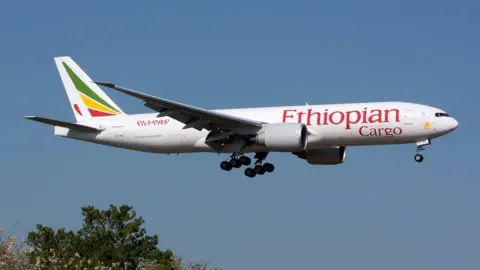Ethiopian Airlines: Africa's largest airline
 Getty Images
Getty ImagesEthiopian Airlines has been shaken by the crash that killed 157 people, but it is widely recognized as Africa's most successful airline.
Voted the Best Airline in Africa in 2018, the airline's triumphs are arguably down to reasonably priced tickets, efficient service delivery, a good safety record and a wide network of flights.
Ethiopian Airlines joined Star Alliance Network, an international airline network giving it access to more routes with partner airlines, in 2011.
It is the largest airline in Africa and one of the few airlines turning a profit in the continent.
In the financial year 2017/2018, Ethiopian Airlines made profits of $245m (£187m) and carried 10.6 million people.
Founded in 1945 by Ethiopia's last emperor Haile Selassie, with the hope of modernising and shaking off the country's poverty-stricken image, the inaugural flight to Cairo via Asmara took place in December that year.

Ethiopian Airlines in numbers
- 74 years old
- 111 planes
- 127 destinations in total
- 10.6 million passengers in 2017/2018
- $3.1b (£2.3b) revenue 2017/2018
- $245m (£187m) profits

It has since expanded and its fleet of 111 planes is larger than any other airline on the continent, flying to 106 international and 23 domestic destinations.
Ethiopian was the first African airline to take delivery of the Boeing 787 Dreamliner and the 757 freighter and has invested in expanding and modernizing its fleet - and this has resulted in it having the youngest fleet in Africa.
The average age of the Ethiopian aircraft is just 5.4 years, compared to 13.5 for British Airways, 15 years for United Airlines and 10.7 for American Airlines.
Ethiopian is one of the safest airlines in Africa, however there have been four major, deadly accidents or incidents involving the carrier.
The last Ethiopian Airlines plane crash happened in 2010 when flight ET409 caught fire five minutes after take-off from Beirut and plummeted into the Mediterranean two miles off the Lebanese coast, killing all 89 passengers and crew.
A Lebanese investigation blamed pilot error for the crash but Ethiopian Airlines rejected the report, saying that the plane exploded, which according to their experts pointed to sabotage, a lightning strike or shooting down.
In 1988 35 people died when an Ethiopian Airline plane's engines ingested pigeons and the aircraft caught fire during a belly-landing at Dahir Bar airport in Ethiopia.
In 1996, a Boeing 767 was infamously hijacked and it ran out of fuel while flying from Ethiopia's capital, Addis Ababa to Nairobi, Kenya. The plane crash-landed in the Indian Ocean near the Comoros Islands, killing 125 of its 175 passengers.
An African leader
Beyond its own operations, the airline has also been helping other African national carriers.
It revived and owns a 49% stake in Malawi Airlines and a 45% stake in Zambia Airways and has announced plans to help re-launch a new airline in Mozambique. It is also in talks to establish smaller regional bases in Djibouti, Chad, and Equatorial Guinea. It already operates hubs in Malawi and Togo.
This strategy of reviving defunct national airlines, launching more connections and setting up more hubs across Africa has helped Ethiopian Airlines become a leader in its industry.
"Ethiopian has really come up with a very smart model for many years now," Max Kingsley-Jones, of aviation publisher FlightGlobal, told the BBC.
"Airline Business [magazine] gave Tewolde Gebremariam [CEO of Ethiopian Airlines] an award for being the best airline serving a particular market. The airline has very extensive network and their strategy of flying into Addis Ababa and then carrying people around the region of Africa, all over Africa, has proven successful", he said.
Ethiopian Airlines also has a good marketing strategy; it recently marked International Women's day by operating an all-female flight from Addis Ababa to Oslo.
Recently, Ethiopia overtook Dubai as the biggest transfer hub for long-haul travel to Africa, according to findings by Spanish travel consultancy ForwardKeys.
The undergoing expansion at Ethiopia's main airport, the Bole International airport, will further enhance the Ethiopian aviation industry's presence in Africa. Once completed, it will be able to accommodate up to 22 million passengers a year - overtaking South Africa's OR Tambo International airport in Johannesburg.
But that is not enough for Ethiopia's Prime Minister Abiy Ahmed.
At the opening ceremony of Ethiopia's largest hotel, adjacent to the airport in January, he said: "We expect the Board and the Management [of Ethiopian Airlines] not to be complacent with the new terminal, but rather to aim for a bigger facility with a capacity to accommodate at least 100 million passengers."
While the crash is a massive shock to the airline, it will continue with its long-term vision.
